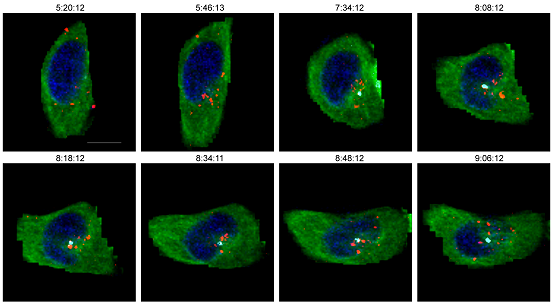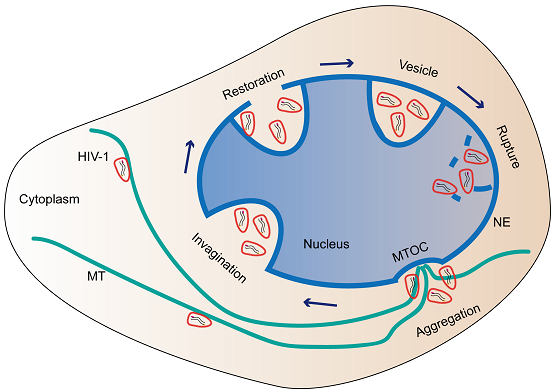On May 15, 2020, Science China-Life Sciences online published a research article entitled "HIV-1 viral cores enter the nucleus collectively through the nuclear endocytosis-like pathway". By combined the use of cellular molecular imaging and electron microscopy, ZHANG Xian-En’s team discovered how can the HIV-1 viral cores entered the nucleus.
It is widely acknowledged that the process of HIV-1 infecting cells undergoes the following steps: membrane fusion, viral core release, reverse transcription, CA disassembly in cytoplasm, nuclear entry of the viral genome, and viral genome integration, followed by reproducing themselves using the host cell system. However, recent studies have found that viral capsids also exist in the nucleus, and play functions of integration site selection and immune escape. The latest report proved that the HIV-1 viral capsid uncoated near the site of chromosome integration. Considering that the size of HIV-1 viral core is much larger than the nuclear pores, how the viral cores pass through the nuclear membrane barrier remains mysterious.
In the current study, selected components of HIV-1 and the host cells are differentially labelled so that the Virus-host cell interaction can be dynamically tracked. It was found that after entering the cell, the viral particles moved along the microtubules and selectively gathered at the microtubule organization center (MTOC), leading the nearby nuclear envelope (NE) to undergo deformation, invagination and restoration to form a nuclear vesicle in which the viral cores were wrapped; then, the inner membrane of the nuclear vesicle ruptured to release HIV-1 into the nucleus. This phenomenon is similar to cell endocytosis and therefore named “nuclear endocytosis-like pathway”. Factors involving in the process were preliminarily investigated. This discovery expands our understanding of the complexity of HIV-1 nuclear entry, which may provide new insights to HIV-1 virology. The molecular details and viral biology of the mechanism need further elucidation.
Huazhong University and two CAS institutes Wuhan Institute of Virology and the Shenzhen Institute of Advanced Technology participated in the research.
This work was supported by the Strategic Priority Research Program of the Chinese Academy of Sciences (Grant No. XDB29050100).

Figure1:Time-lapse fluorescence snapshots of the HIVVpr-mCherry (NL4-3(KFS)) in TZM-bl cells. The aggregation of viral particles in the MTOC and their transport into the nucleus were dynamically traced. Stained for DNA (blue), MT (green), and MTOC marker protein γ-tubulin (turquoise). Scale bars, 10μm.

Figure 2: Model of HIV-1 nuclear entry.
(The image by Dr. ZHANG Xian-En’s lab)
The web link for this paper is http://engine.scichina.com/doi/10.1007/s11427-020-1716-x
Contact: ZHANG Xian-En
Institute of Biophysics, Chinese Academy of Sciences
Beijing 100101, China
Phone: 86-10-64888148
Email: zhangxe@ibp.ac.cn
(Reported by Dr. ZHANG Xian-En's group)